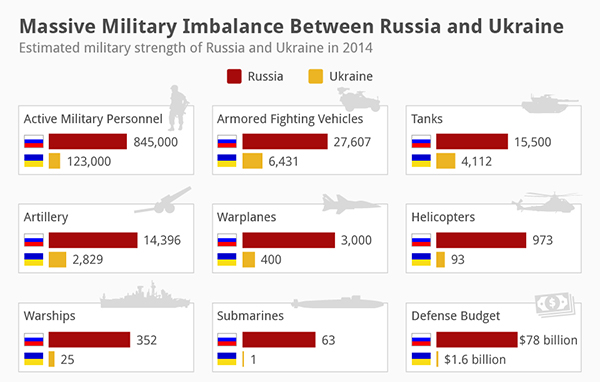Ukraine’s armed forces are heavily outnumbered and outnumbered by Russia’s.
In terms of manpower and weapons, the arithmetic looks grim for Ukraine. The number of Russian troops near Russia’s border with Ukraine before the invasion began were more than 100,000. Russia also moved some troops to Belarus, north of Ukraine, for military drills.
Estimates of the numbers of new Russian troops moved closer to Ukraine vary from 60,000 to around 100,000, with a U.S. intelligence document suggesting that number could be ramped up to 175,000.
Personnel and Equipment
While western European nations have contributed military equipment to Ukraine in the recent past, the country’s military capabilities pale in comparison to Russia’s, which has among the mightiest armed forces in the world.
Although Ukraine trebled its defence budget in real terms from 2010 to 2020, its total defence expenditure in 2020 amounted to only $5.9 billion, or one-tenth of Russia’s, according to the Stockholm International Peace Research Institute (SIPRI), which tracks global arms trade, at US$ 61.7 billion.
In a head-to-head comparison of the military capabilities of the two nations, Russia outnumbers Ukraine in almost every aspect. According to Global Fire Power, which has been analysing the military capabilities of countries across the world since 2006, while Russia is the second most powerful country militarily, Ukraine is ranked 22 out of 140 nations.
Russia has nearly 850,000 active personnel, which is more than three times 250,000 for Ukraine. In terms of airpower, Russia has more than 4,100 aircraft, with 772 fighters, while Ukraine only has 318 total aircraft, with just 69 fighter aircraft.
Similarly, in terms of ground forces, Russia has around 12,500 tanks and more than 30,000 armoured vehicles, while Ukraine only has around 2,600 tanks and 12,000 armoured vehicles. While Russia has around 14,000 towed and self-propelled artillery guns, Ukraine’s total number is just over 3,000.
Although navies are unlikely to make any direct contact in this conflict, still, Russia has more than 600 naval vessels, including one aircraft carrier, compared to the total 38 naval vessels with Ukraine. For stealth capabilities in the sea, Russia has 70 submarines, to zero for Ukraine.
Beyond the regular army, Ukraine has volunteer territorial defence units and around 900,000 reservists. Most adult males have at least basic military training, so Russia could find itself facing stubborn and protracted resistance if it tried to capture and hold onto territory.
Ukraine’s anti-aircraft and anti-missile defences are weak, leaving it highly vulnerable to Russian strikes on its critical infrastructure. They also have short-range air defences and anti-tank weaponry, including U.S.-supplied Javelin missiles, which would help to slow any Russian advance.
Russia would seek to use its superiority in electronic warfare to paralyse its adversary’s command and control and cut off communications with units in the field.
Ukrainian Experience
Ukraine’s army is also better trained and equipped than in 2014, when Russia captured the Crimea peninsula from Ukraine without a fight, and is widely seen as highly motivated to defend the country’s heartland. Ukraine’s forces gained combat experience in the Donbass region in the east of the country, where they have been fighting Russia-backed separatists since 2014, and are highly motivated.
The military challenge would be incomparably higher than in previous wars Russia has fought since the Soviet Union’s collapse, including in breakaway Chechnya in the 1990s and against Georgia in 2008.
Western Military Aid
Western countries have stepped up arms deliveries to Ukraine, but Kyiv says it needs more. The United States has ruled out sending U.S. troops to Ukraine to fight.
The United States has provided more than $2.5 billion in military aid since 2014, including Javelin anti-tank missiles, coastal patrol boats, Humvees, sniper rifles, reconnaissance drones, radar systems, night vision and radio equipment. Further supplies could include Stinger anti-aircraft missiles, small arms and boats.
Ukraine’s Defence Minister Oleksii Reznikov said, on 23 January 2022, the country had received a second consignment of weapons from the United States as part of defensive aid totalling $200 million.
Ukraine had been arming itself with anti-tank missiles taken from the US, though. Hundreds of the Javelin missiles have been given to Ukraine since December, which will help Ukrainian troops to target Russian tanks. It is a man-portable fire-and-forget anti-tank missile, which means that a soldier can fire it from his shoulder, and its automatic infrared guidance system will target the tanks from above, which is the weakest part of any tank.
Washington has said it would continue to support Ukraine amid concerns in Kyiv and among its Western allies over tens of thousands of Russian troops amassed on its border. Russia denies planning a military offensive. About 90 tonnes of “lethal security assistance”, including ammunition, from the package approved by the U.S. in December 2021.
At the beginning of the Ruyssian invasion, countries across the globe have offered their military support to the Ukrainian government. European Commission president Ursula von der Leyen announced, on 28 February, that the EU would finance the purchase and delivery of arms to Ukraine totalling €450 million. Some countries in the bloc would also be sending fighter jets, the EU’s foreign chief Josep Borrell announced. In another major shift, Germany has broken its long-standing foreign policy of banning all exports of lethal weapons to conflict zones.
Listed alphabetically, here is what donor countries have announced.
* Belgium – 2,000 machine guns, 3,800 tons of fuel, 3,000 additional automatic rifles and 200 anti-tank weapons.
* Canada – helmets, bulletproof vests, anti-tank weapons, ammunition.
* Croatia – €16 million worth of protective gear and light arms
* Czech Republic – 30,000 pistols, 7,000 assault rifles, 3,000 machine guns, sniper rifles, ammunition.
* Czech Republic – military equipment.
* Denmark – 2,700 anti-tank weapons, volunteer brigade.
* EU – will finance the purchase of arms for €450 mn
* Finland – 2,500 assault rifles, 150,000 rounds of ammunition, 1,500 rocket launchers, 70,000 field rations.
* France – defence equipment and fuel support.
* Germany – 1,000 anti-tank rocket launchers, 500 Stinger surface-to-air missiles, nine Howitzers, 14 armoured vehicles and 10,000 tonnes of fuel to Ukraine.
* Italy – military equipment.
* Netherlands – weapons and protective equipment, 200 Stingers
* Norway – helmets, bulletproof vests, 2,000 M72 anti-tank weapons.
* Portugal – bulletproof vests, helmets, night vision goggles, grenades and ammunition.
* Portugal – military equipment.
* Romania – fuel, body armour, helmets, ammunition, military equipment, medical treatment.
* Slovenia – rifles, ammunition and helmets.
* Sweden – anti-tank weapons
* USA – €350 million military aid package (adds up to €1 billion over last one year).
Although US troops were not being sent to Ukraine, the US was prepared to put as many as 8,500 troops on heightened alert part of the NATO Response Force, if that group is activated for deployment in Eastern Europe if needed, offering a show of military force alongside diplomatic efforts to defuse the crisis. The NATO Response Force numbers 40,000 personnel drawn from multiple nations.
NATO Secretary General Jens Stoltenberg said the 30-nation alliance’s new military deployments in eastern Europe are defensive and do not threaten Russia. “I welcome that allies are stepping up,” Stoltenberg told reporters in Brussels, mentioning moves including Denmark sending a frigate to the Baltic Sea and deploying fighter jets to Lithuania, and France expressing readiness to send troops to Romania under NATO command.


















